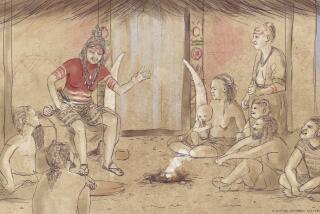Women did most prehistoric cave paintings: Religion, or just lazy men?
- Share via
Do you like prehistoric cave paintings? No? Well, I do, and so the news that many of those paintings were apparently done by women is fascinating. Not only for what it says about our ancestors but for what it says about archeology.
Writing for National Geographic, Virginia Hughes reported recently:
Women made most of the oldest-known cave art paintings, suggests a new analysis of ancient handprints. Most scholars had assumed these ancient artists were predominantly men, so the finding overturns decades of archaeological dogma.
Archaeologist Dean Snow of Pennsylvania State University analyzed hand stencils found in eight cave sites in France and Spain. By comparing the relative lengths of certain fingers, Snow determined that three-quarters of the handprints were female.
On a trip to France a few years ago, my wife and I took our two sons on a tour of a small cave to see its ancient drawings. The cave was dark and chill and damp, but that wasn’t the reason we shivered: It was awe-inspiring to crouch in the shadows and see those drawings done so long ago by our ancestors.
What was equally interesting was how you viewed the paintings. As the guides demonstrated, the animals looked one way when spotlighted with modern lighting: interesting but not very impressive. But when those lights were turned off and the paintings were illuminated by the dimmer light of flashlights, we saw the animals as their creators intended; they came alive. The artists, who painted by the dim light of torches and the like, had used the natural features of the rock walls themselves to give their subjects an almost 3D quality. It was as if you were standing there, looking at them just after their creators had left.
Now, no one really knows why ancient man painted the animals he hunted. Nor why the artists left handprints on the walls next to them. Was it religious in nature? To ensure a good hunt? Was it simply man’s desire to leave his mark?
And notice I keep saying “man.” But now we know it wasn’t just men but women too — primarily women, in fact. Another “why.”
Was it just an ancient twist on the adage: Those who could, hunted animals; those who couldn’t hunt (women, young boys) painted them? Or maybe, like their modern counterparts, cave women grew tired of waiting for their mates to do the job and just went ahead with some interior decorating?
We’ll probably never know. But as for why archaeologists and others for years thought that the painters were mostly men, there may be a more modern reason: sexism.
As Nidhi Subbaraman of NBC News wrote:
Male archaeologists from modern society where gender roles are rigid and well-defined — they found the art. “[M]ale archaeologists were doing the work,” Snow said, and it’s possible that “had something to do with it.”
Ah, yes: Those who write history often determine who makes history.
ALSO:
Photo essay: Five women more newsworthy than Miley
Tea party wants to take America back -- to the 18th century
Follow Paul Whitefield on Twitter @PaulWhitefield1 and Google +
More to Read
A cure for the common opinion
Get thought-provoking perspectives with our weekly newsletter.
You may occasionally receive promotional content from the Los Angeles Times.










